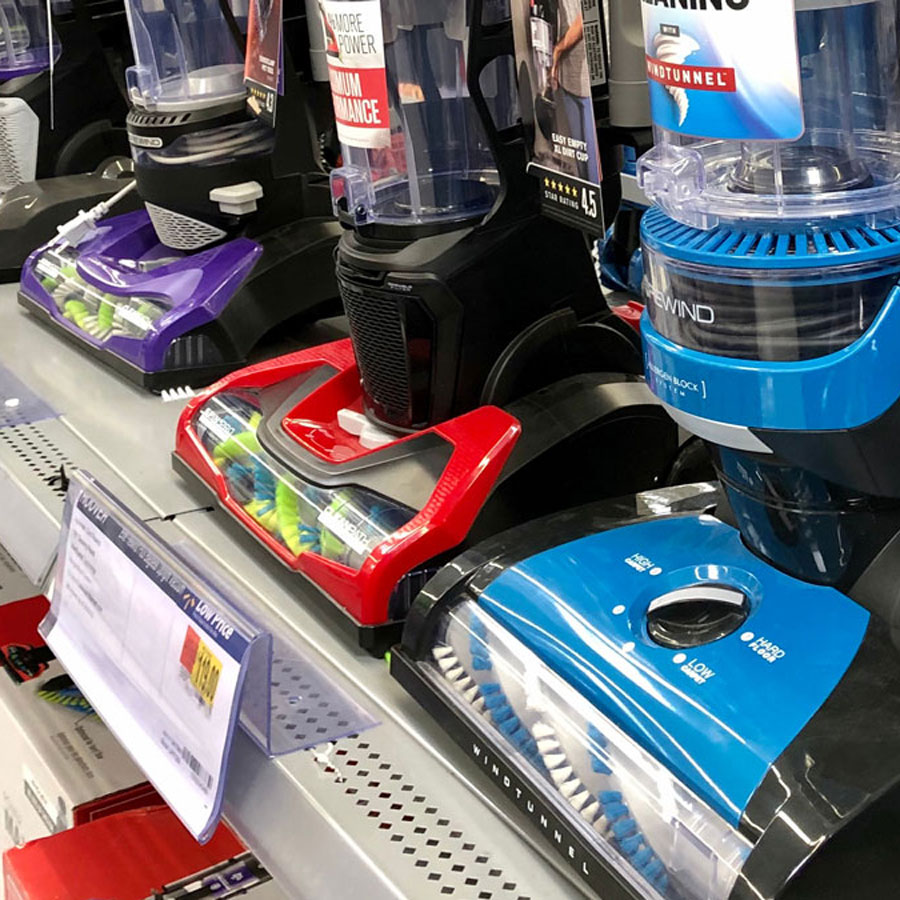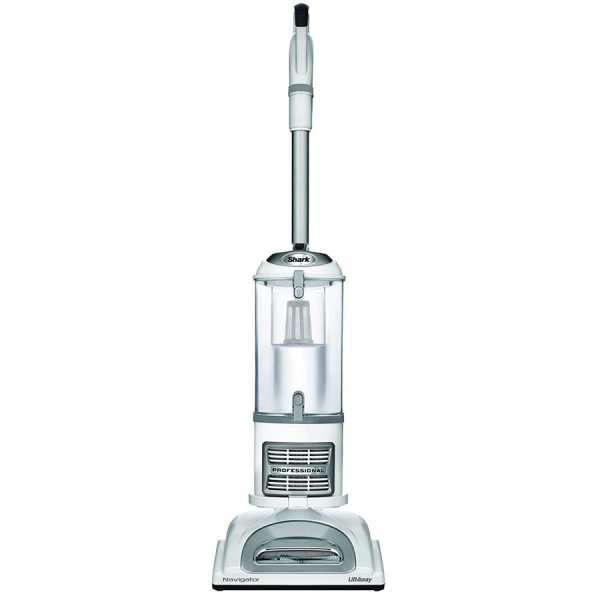When choosing a vacuum cleaner, the upright vacuum vs. canister vacuum comparison is one you will often find yourself making.
Upright vacuums are very common, but at present, many households are choosing canister vacuums for their everyday cleaning needs.
Vacuum cleaners are essential home appliances that make housecleaning a less tiring job. They clean a lot more efficiently than the usual age-old brooms and brushes.
Whether it’s dust, dirt, or pet hair, a vacuum cleaner can suck it all up by way of its powerful suction mechanism. It will leave your house clean and fresh.
Choosing between an upright vacuum and a canister vacuum can be difficult.
Upright vacuum cleaners have a recognizable design: everything is fitted cozily inside the vacuum’s body. The motor, suction head, handle, and a collection cylinder or dust bag are all part of the vacuum’s body that the user has to push in front of him.
Canister vacuum cleaners are slightly different in that the vacuum unit, fitted with wheels, contains the engine, filter, and collection cylinder or dust bag. However, the cleaning nozzle goes at the end of a wand with a handle linked to the central vacuum unit with a flexible hose.
Until recently, upright models were the most common choice for houses with a lot of carpets and rugs, while households with mostly hard floors would opt for canister models. Recent technical innovations with both types of vacuum cleaners blur the line, and the distinction isn’t as straightforward as it used to be.
Hard Floors
When it comes to bare floors such as hardwood, vinyl, tiles, and other uncarpeted floor surfaces, canister vacuums are generally a better choice.
Most canister vacuums come with an easy-to-use on / off switch for the vacuum’s brush making it particularly easy to improve suction for hard floors. Some more advanced models even include a bare-floor setting that will enhance its performance even further.
Carpets
Thanks to their motorized brushes, Upright vacuum cleaners are better at deep cleaning carpets and rugs than their canister counterparts.
Brush agitators, or roller brushes, can be found on almost every upright vacuum. This agitator has bristles attached to its central axis that span the full width of the suction head. When the brush agitator rotates, the strands pull dust, dirt, and grit from your carpets, and it gets sucked in.
In recent years, some vacuum manufacturers have started to equip their canister vacuums with special motorized brush attachments that replicate upright vacuums’ functionality. As a result, some canister vacuums have become as effective at cleaning carpets and rugs. Still, the fact that it’s yet another attachment you have to attach to the vacuum manually can deter some users.
Stairs
Canister vacuums are better than upright vacuums for cleaning stairs, as it is almost impossible or down-right hazardous to clean steps with an upright vacuum.
Maneuvering a canister vacuum in stairs and tight spaces is more comfortable thanks to their flexible hose and lightweight wand. Keep in mind that you only need to move the rod and not the entire vacuum cleaner.
There’s always a risk that you might trip while carrying your heavy upright vacuum to the top of your stairs, and its bulky head design will make it challenging to clean each step thoroughly to the walls.
Upholstery
When it comes to upholstery and drapes, canister vacuums are a better choice thanks to the variety of brushes they come equipped with, such as crevice nozzles and upholstery brushes.
Canister vacuums’ design, with the central vacuum unit separated from the wand with the suction nozzle, means that you can easily lift the rod to clean upholstery. Good luck raising an upright vacuum above your head to clean your curtains.
Efficiency
There are several things to consider when discussing a vacuum cleaner’s efficiency, such as its cleaning swath and motor power.
Upright vacuums tend to have a wider suction head than canister models, so they can cover a wider cleaning swath and generally perform better for large areas as you will cover more ground in less time.
Also, since canister vacuums generally have more powerful motors, they can compensate for their narrower cleaning swath with a more efficient suction, which means you won’t have to vacuum twice in the same spot, ever.
Maneuverability
Canister vacuums, being less bulky, are generally better for cleaning under furniture than upright models. While the body of a canister vacuum is more cumbersome than an upright vacuum, the fact that the wand and head are uncoupled from the body makes it easier to maneuver, clean corners and hard to reach places.
While upright vacuums are great at covering large areas, if your rooms have many nooks and crannies, an upright vacuum might not be such a clear better choice. The bulkier design will make it harder to maneuver, get behind furniture, and clean tight corners.
Dragging the canister of a canister vacuum behind you can cause it to hit furniture or walls and leave marks behind (unless there is some well-placed rubber on the sides of the canister), or the wheels under the canister can get stuck in thick carpets.
The main issue when talking about a vacuum’s maneuverability has to be back pain. Canister vacuums are generally lower to the ground, and they have a shorter wand, which can mean repetitively bending over.
Some canister vacuum cleaners come with hand controls on the wand and a power button big enough to be used with your feet. These will only partially reduce the bending occurrences as the wand’s length will require you to bend down slightly when vacuuming.
Weight
An important consideration when choosing between an upright vacuum and a canister vacuum is its weight.
A canister vacuum can weigh as little as 7.5 lbs, and you probably won’t find a single upright vacuum in this weight range. Moreover, the vacuum unit’s separation from the wand and suction head in a canister vacuum will make it seem significantly lighter as you won’t be pushing and pulling the whole vacuum’s weight.
On the other hand, an upright vacuum will easily weigh upwards of 20 lbs. Dragging such a heavy vacuum back and forth might get tiresome after just a few minutes, except if it’s self-propelled. Additionally, an upright vacuum is also much harder to carry in stairs.
While self-propulsion can seem like an easy fix to the weight issue with upright vacuums, this feature typically uses a transmission and drive system to assist the vacuum’s pushing and pulling. The downside is that it adds even more weight to an already heavy vacuum, making it even more challenging to carry.
Power
Upright vacuums having their unibody design, there are some limitations to their engine’s size, and consequently to their suction power. Effectively, you can’t be lugging around a super-heavy machine and pushing it back and forth for extended periods.
Canister vacuums don’t have the same limitation: there is technically no limit to their engine’s size; thus, they are generally more powerful. They have better suction and flow-rate, which means more comfortable and faster cleaning.
Noise
You might think that canister vacuums would be noisier with their more powerful engines, but that’s not the case. Since canister vacuums aren’t limited in size, there is room for better sound insulation.
Uprights vacuums tend to be noisier than canister vacuums. Most canister vacuums emit between 60 and 65 decibels, while upright vacuums generally emit upward of 75 decibels.
You might see advertisements for “quiet” upright vacuums, but most sound like an airplane taking off. Unfortunately, it’s a consequence of their unibody design that leaves little room for insulation to muffle sounds.
Cleaning
Emptying all the dust, dirt, and debris sucked by your vacuum cleaner won’t be such a different process for a canister vacuum and an upright vacuum.
It’s mostly a matter of it being a bagged or bagless vacuum cleaner. Most upright vacuum cleaners are bagless and equipped with a collection cylinder that easily snaps into place and will be a breeze to clean-up. But you can also find some bagless canister vacuums, so it’s not a factor to choose one or the other.
On the other end of the spectrum, you can find bagged upright vacuum cleaners as well as bagged canister vacuum cleaners. The latter being the most common. Having a bagged vacuum cleaner might cost a bit more since you’re purchasing bags. Still, you’ll save time on filters that need periodic cleaning for bagless vacuums, as well as money on HEPA filters that need regular replacing.
Also, emptying a bagless vacuum cleaner will be a messier task as there will always be some dust escaping. That could be important if someone in your household has asthma or allergies.
Filter
Nowadays, an increasing number of vacuum cleaners (both uprights and canisters) claim to filter fine particles that could pass through the machine and escape into the air.
The most efficient type of filter is called HEPA and can prove very useful at reducing emissions. HEPA filtration can benefit people with asthma and allergies.
Unfortunately, models equipped with such filters are generally more expensive than models with micron filters and standard filters. It’s also important to keep in mind that HEPA filters need regular replacing to stay 100% effective.
Storage
Upright vacuums are relatively easy to store since they can stand up on their own. Some even come with a hook so that you can hang them against a wall. That makes them a great option if you have limited storage space.
Canister vacuums come with many handy attachments and quite a lengthy flexible hose that will take up a fair amount of space and make them harder to squeeze into a small closet.
When it comes to storage, a great feature of canister vacuums is their retractable power cord. Most models have a cord of at least 20 feet, and sometimes even longer than 30 feet. Such a long cord could quickly become a hindrance for storage, but a slight tug or the push of a button allows you to rewind the whole cord that ends up hidden inside the vacuum cleaner body.
Generally, upright vacuums don’t have a retractable power cord and come equipped with a cord-release clip that lets you free the entire cord at once, rather than one wrap at a time. However, you’ll have to roll it back one wrap at a time after use.
Price
On average, upright vacuums tend to cost less than canister vacuums. However, you’ll want to consider the type of filters in the vacuum cleaner and if it’s bagged or bagless, as this can have a significant impact in the long run.
A part breaking down inside an upright vacuum will generally mean an expensive repair bill or even replacing the whole vacuum cleaner, which isn’t so great for the environment and your wallet.


